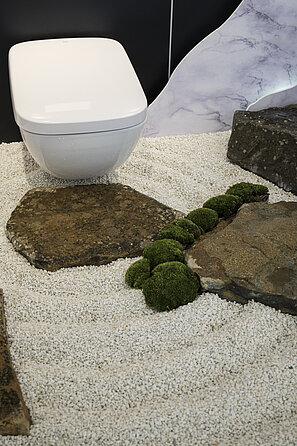Culture & Lifestyle
|22/05/2024
A TOTO’ally Zen experience

Zen gardens are a fascinating feature of Japanese culture and this summer TOTO celebrates this venerable tradition at a special exhibition at our London showroom. Designed by Emi Morita, a Japanese landscape designer, the installation will be available to visit from 20 May - 31 July 2024. Alongside the garden there will be a unique Japanese Tea House designed by London based architects Squire & Partners.

The synergy between Japanese design and culture runs deep from the aesthetics, harmony and refinement. This is also integrated into nearly every TOTO product following the philosophy of an “understated presence”. To realise this, all TOTO designers have to meet three principles without compromise. For one, they need to develop a “user-friendly design” that supports the person’s body and spirit in their everyday life. The aesthetic elements of the product should also create “harmony” in the space. Finally, the design must have “true beauty”, which refers to its suitability for long term use.

Both TOTO designs and Japanese gardens provide areas with a tranquil environment conductive to relaxation and mindfulness. Their minimalist designs foster a sense of calmness, contributing to improved wellbeing. The carefully arranged elements within bathrooms establish a sense of balance and rhythm within a space similar to that of a Japanese garden, whether integrated into residential or hotel projects.
Zen gardens often feature carefully raked patterns in the gravel or sand, symbolising ripples in water or flowing streams. Large rocks, called "islands" or "mountains" are strategically placed to represent these natural formations. Moss may be used to symbolise landmasses, and sometimes simple vegetation like bonsai trees or small shrubs are included.

Zen gardens have a rich history deeply rooted in Japanese culture and Zen Buddhism. They originated in Japan during the Muromachi period (1333–1573) and have since become synonymous with tranquility, simplicity, and meditative contemplation.
The concept of Zen gardens evolved from the practice of creating landscapes within Buddhist temples, with the intention of facilitating meditation and reflection. While the precise origins of Zen gardens are not fully documented, it's believed that they were influenced by Chinese garden design principles, particularly those of the Song Dynasty.
One of the most famous Zen gardens is the Ryoan-ji Temple garden in Kyoto, Japan, created in the late 15th century. This garden is renowned for its simplicity and abstract composition, consisting of fifteen rocks placed on a bed of raked white gravel. The arrangement of the rocks is such that no matter where one sits in front of the garden, only fourteen rocks are visible at one time, a deliberate design to encourage contemplation and meditation.

Zen gardens became increasingly popular in Japan during the Edo period (1603–1868), spreading from monasteries to the residences of aristocrats and samurai warriors. During this time, Zen gardens also began to incorporate elements of tea ceremony houses, with tea masters designing gardens to complement their tea houses.
In the modern era, Zen gardens continue to be valued for their aesthetic beauty and as places of reflection and meditation. They continue to influence architects and landscape designers around the world, with many people incorporating elements of Zen gardens into their own projects as a way to create peaceful and harmonious outdoor spaces.